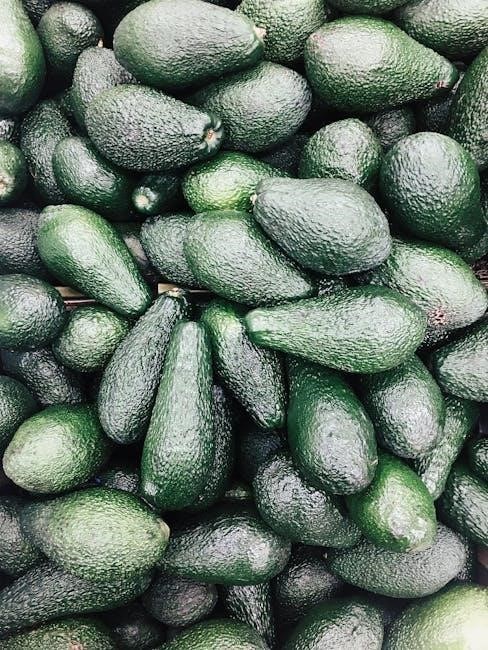The keto diet is a high-fat, low-carbohydrate eating plan that promotes weight loss, improves metabolic health, and increases energy levels by inducing a metabolic state called ketosis.
What is the Keto Diet?
The keto diet, or ketogenic diet, is a high-fat, low-carbohydrate, moderate-protein eating plan designed to induce a metabolic state called ketosis. By drastically reducing carb intake, the body shifts from using glucose as its primary energy source to burning fat, producing ketones in the process. This dietary approach aims to promote weight loss, improve metabolic health, and increase energy levels. It focuses on whole, nutrient-dense foods like meats, fatty fish, eggs, healthy fats, and low-carb vegetables, while avoiding sugars, grains, and processed foods. The keto diet has gained popularity for its potential to transform body composition and enhance overall well-being.
Benefits of the Keto Diet
The keto diet offers numerous benefits, including significant weight loss, improved metabolic health, and increased energy levels. By inducing ketosis, the body efficiently burns fat for fuel, leading to a reduction in body fat. It also helps regulate blood sugar levels, which can be particularly beneficial for those with type 2 diabetes. Many people report improved mental clarity and reduced hunger due to the diet’s focus on high-fat, nutrient-dense foods. Additionally, the keto diet has been shown to lower triglycerides and improve overall cardiovascular health. Its structured approach makes it easier to stick to long-term, promoting sustainable lifestyle changes and enhanced well-being.
How the Keto Diet Works
The keto diet works by drastically reducing carbohydrate intake, forcing the body to enter a metabolic state called ketosis. In this state, the body shifts from relying on glucose (sugar) for energy to burning fat, producing molecules called ketones. By limiting carbs to 20-50 grams per day, the body depletes its glucose stores, prompting the liver to break down fat into ketones, which become the primary energy source. This process not only burns stored fat but also suppresses appetite and stabilizes blood sugar levels. The diet typically consists of 70-80% fat, 15-20% protein, and 5-10% carbs, ensuring sustained ketosis for optimal results.

Importance of Meal Planning on the Keto Diet
Meal planning is essential for staying on track, avoiding temptation, and ensuring nutritional balance. It saves time, reduces food waste, and helps maintain ketosis consistently.
Why Meal Planning is Crucial for Success
Meal planning is vital for keto success as it helps avoid temptation, saves time, and ensures nutritional balance. By structuring meals in advance, you prevent improvisation, which often leads to unhealthy choices. A well-planned menu guarantees that you stay in ketosis by maintaining the right balance of fats, proteins, and low-carb vegetables. It also helps avoid hidden carbs in seemingly keto-friendly foods. Additionally, meal planning reduces decision fatigue, allowing you to stay focused on your goals without constant deliberation. This structured approach ensures consistency, making it easier to achieve and maintain ketosis while enjoying delicious and varied meals.
How to Avoid Common Mistakes
Avoiding common mistakes on the keto diet requires careful attention to macronutrient ratios and food choices. Many people overconsume protein or underestimate hidden carbs in sauces and processed foods, which can disrupt ketosis. Staying hydrated and listening to your body are also crucial, as dehydration and electrolyte imbalances are frequent issues. Additionally, avoid relying on keto-labeled products, as they may contain hidden sugars or unhealthy ingredients. Tracking your meals and macros can help you stay on track and prevent accidental carb overconsumption. By being mindful of these pitfalls, you can maintain ketosis and achieve your health goals more effectively.

Foods to Eat and Avoid on the Keto Diet
Focus on high-fat foods like avocados, olive oil, and fatty meats, moderate protein, and low-carb vegetables. Avoid sugars, grains, and processed foods to maintain ketosis effectively.
Allowed Foods: Proteins, Fats, and Low-Carb Vegetables
On the keto diet, focus on high-quality proteins like meats, poultry, fatty fish, and eggs. Healthy fats such as olive oil, avocado, and butter are essential. Include low-carb vegetables like spinach, broccoli, and cauliflower. Nuts, seeds, and small portions of berries are also permitted. Dairy options like cheese and Greek yogurt can be added in moderation. These foods provide the necessary nutrients while keeping carbohydrate intake low, supporting ketosis and overall health. Always choose whole, unprocessed foods to maximize benefits and avoid hidden carbs or sugars.
Foods to Avoid: High-Carb and Processed Foods
To maintain ketosis, avoid high-carb foods like sugars, grains, starchy vegetables, and legumes. Processed foods, sugary drinks, and high-sugar fruits should also be excluded. Refined oils and alcohol are discouraged. These foods can disrupt ketosis and hinder weight loss. Focus on eliminating bread, pasta, rice, potatoes, and foods with added sugars or artificial ingredients. Avoiding these ensures you stay on track with your keto goals and maintain optimal health benefits.

Sample Weekly Keto Meal Plan
A structured 7-day meal plan with breakfast, lunch, and dinner ideas, ensuring low-carb, high-fat meals to maintain ketosis. Includes recipes like scrambled eggs with spinach and salmon.
Monday: Breakfast, Lunch, and Dinner Ideas
Start your week with a delicious keto-friendly breakfast of scrambled eggs with spinach, avocado, and a sprinkle of cheese. For lunch, enjoy grilled salmon with a side of steamed broccoli drizzled with olive oil. Dinner could feature a hearty chicken salad with mixed greens, olive oil dressing, and crushed nuts. These meals are designed to keep you in ketosis while providing balanced nutrition. Each recipe is simple, flavorful, and uses accessible ingredients. Download the free keto meal plan PDF for a full week of organized, low-carb meals to help you stay on track with your diet goals.
Tuesday: Breakfast, Lunch, and Dinner Ideas
Begin Tuesday with a keto smoothie made from almond milk, protein powder, spinach, and a touch of almond butter. For lunch, try a chicken stir-fry with cauliflower rice, bell peppers, and olive oil. Dinner could feature a beef stir-fry with zucchini noodles and a side of avocado slices. These meals are designed to be flavorful and keep you in ketosis. Each recipe uses simple, accessible ingredients and aligns with the keto diet’s low-carb, high-fat principles. Download the free keto meal plan PDF for a full week of organized, delicious meals to support your weight loss and health goals.
Wednesday: Breakfast, Lunch, and Dinner Ideas
Start Wednesday with scrambled eggs, mushrooms, and avocado for breakfast. For lunch, enjoy a grilled chicken salad with mixed greens, olive oil, and a sprinkle of seeds. Dinner features a beef stir-fry with bell peppers, zucchini, and a side of cauliflower rice. These meals are balanced, flavorful, and designed to keep you in ketosis. Each recipe uses simple, accessible ingredients and aligns with the keto diet’s low-carb, high-fat principles. Download the free keto meal plan PDF for a full week of organized, delicious meals to support your weight loss and health goals.
Thursday: Breakfast, Lunch, and Dinner Ideas
Thursday begins with a hearty keto smoothie made from almond milk, protein powder, spinach, and almond butter. For lunch, enjoy chicken curry with cauliflower rice and a side of sautéed green beans. Dinner features grilled steak paired with roasted Brussels sprouts and a drizzle of olive oil. These meals are designed to keep you satisfied and on track with your keto goals. Each recipe is simple, flavorful, and uses ingredients that are easy to find. Download the free keto meal plan PDF for a full week of delicious, low-carb meals to support your health journey.
Friday: Breakfast, Lunch, and Dinner Ideas
Friday starts with a keto smoothie blending avocado, protein powder, and almond milk. Lunch features a tuna salad mixed with mayonnaise, diced avocado, and tomatoes, served on a bed of lettuce. For dinner, enjoy grilled salmon with a side of roasted asparagus and a small green salad. These meals are designed to keep you in ketosis while satisfying your taste buds. Each recipe is easy to prepare and uses ingredients readily available in most supermarkets. Download the free keto meal plan PDF for a full week of delicious, low-carb meal ideas to support your keto journey.
Saturday: Breakfast, Lunch, and Dinner Ideas
Start Saturday with scrambled eggs mixed with cheese, spinach, and avocado. For lunch, enjoy grilled chicken breast paired with a side of cauliflower rice and a drizzle of olive oil. Dinner features beef stir-fry with zucchini, bell peppers, and a light soy sauce, served over a bed of shredded cabbage. These meals are flavorful, low in carbs, and easy to prepare. Download the free keto meal plan PDF for a full week of delicious and balanced keto recipes to keep you on track with your diet.
Sunday: Breakfast, Lunch, and Dinner Ideas
Begin Sunday with keto pancakes made from almond flour, topped with butter and a sugar-free syrup. For lunch, enjoy a chicken Caesar salad with romaine lettuce, parmesan cheese, and a homemade keto dressing. Dinner features beef burgers without the bun, served with a side of roasted broccoli and a sprinkle of cheddar cheese. These meals are designed to keep you satisfied and on track with your keto goals. Download the free keto meal plan PDF for more creative and delicious meal ideas to enjoy throughout your week.

Benefits of a Weekly Keto Meal Plan

A weekly keto meal plan saves time, reduces food waste, and ensures nutritional balance. It helps maintain consistency, prevents cravings, and keeps you motivated on your keto journey;
Time and Money Savings
A weekly keto meal plan helps save time by streamlining grocery shopping and meal prep. With a clear list of ingredients, you avoid impulse buys and reduce food waste. Planning meals in advance ensures every grocery trip is purposeful, saving both time and money. By knowing exactly what to buy and cook, you minimize last-minute decisions and avoid costly dining out. This structured approach also helps you use ingredients efficiently, reducing waste and stretching your budget further. A well-organized meal plan is a practical way to stay consistent with your keto diet while being cost-effective and time-efficient.

Improved Consistency and Motivation
A weekly keto meal plan enhances consistency by providing a clear roadmap for meals, eliminating decision fatigue and reducing the likelihood of impulsive choices. Having a structured plan motivates individuals to stay on track, as it removes uncertainty about what to eat. It also fosters accountability, making it easier to adhere to the diet long-term. By following a set schedule, dieters build habits that support their goals, such as regular meal prep and mindful eating. This consistency boosts motivation, as seeing progress and feeling organized reinforces commitment to the keto lifestyle. Over time, this structured approach leads to greater success and confidence.
Ensuring Nutritional Balance
A weekly keto meal plan ensures nutritional balance by carefully selecting meals that meet macronutrient needs. It prioritizes healthy fats, moderate proteins, and low-carb vegetables, avoiding hidden sugars and processed foods. Balanced meals prevent deficiencies and maintain ketosis. Each day’s menu is designed to provide essential vitamins, minerals, and fiber, supporting overall health. This structured approach guarantees that meals are varied and nutrient-dense, reducing the risk of overconsumption of any single food group. By focusing on whole, unprocessed foods, the plan promotes long-term well-being and sustained energy levels, making it easier to stick to the keto diet without compromising nutrition.

Frequently Asked Questions
Common questions about the keto diet include substituting ingredients, handling cravings, and repeating meal plans. These topics are addressed to ensure a smooth and successful keto journey.

Can I Substitute Ingredients?
Yes, ingredients can be substituted in keto meal plans to suit preferences or dietary needs. For example, if you don’t like salmon, you can use chicken or eggs instead. The key is to maintain a balance of healthy fats, moderate protein, and low-carb options. Substitutions should align with keto principles to avoid disrupting ketosis. This flexibility allows for personalization and ensures the diet remains enjoyable and sustainable. Always opt for low-carb alternatives and focus on nutrient-dense foods to maintain the integrity of the keto diet.
How to Handle Cravings
Cravings are normal, especially when starting the keto diet. To manage them, opt for keto-friendly alternatives like sugar-free chocolate, mousse, or berries with whipped cream. Staying hydrated and eating nutrient-dense meals can also reduce cravings. If you experience strong urges, consider healthy fats like avocado or nuts to satisfy your hunger. Consistency is key, and over time, cravings for high-carb foods typically diminish as your body adapts to ketosis. Remember, small indulgences in keto-approved treats can help you stay on track without derailing your progress.
Can I Repeat the Meal Plan?
Yes, repeating the meal plan is not only allowed but often recommended, especially for beginners. Consistency helps maintain ketosis and simplifies grocery shopping. Repetition ensures you stay on track without the hassle of daily meal decisions. Over time, you can introduce new recipes or adjust the plan based on your preferences. The key is to focus on whole, nutrient-dense foods and avoid hidden carbs. By sticking to the plan, you’ll build a strong foundation for long-term success on the keto diet.

Additional Resources
- Download a free keto meal plan PDF for a structured guide to weekly meals.
- Explore further reading and guides for tips, recipes, and expert advice.
Free Keto Meal Plan PDF Download
Download a free keto meal plan PDF to kickstart your journey. This comprehensive guide includes a 7-day meal plan with 21 easy recipes for breakfast, lunch, and dinner. Designed for beginners, it ensures you stay in ketosis with real, accessible foods. The PDF also includes shopping lists and tips for maintaining a low-carb lifestyle. Perfect for those starting or restarting keto, it offers practical meal ideas and nutritional guidance. Available for free, this resource is part of a larger guide to help you succeed on your keto journey.
Further Reading and Guides
Explore additional resources to deepen your understanding of the keto diet. A free 8-week keto plan provides a structured approach with recipes, snack ideas, and meal planning tips. Designed for consistency, it helps maintain ketosis without complexity. Downloadable guides offer detailed insights into macronutrient balance, avoiding hidden carbs, and managing cravings. These resources are ideal for beginners and experienced followers alike, ensuring a well-rounded approach to the keto lifestyle. Enhance your journey with practical tools and expert-backed advice tailored to your dietary needs.
